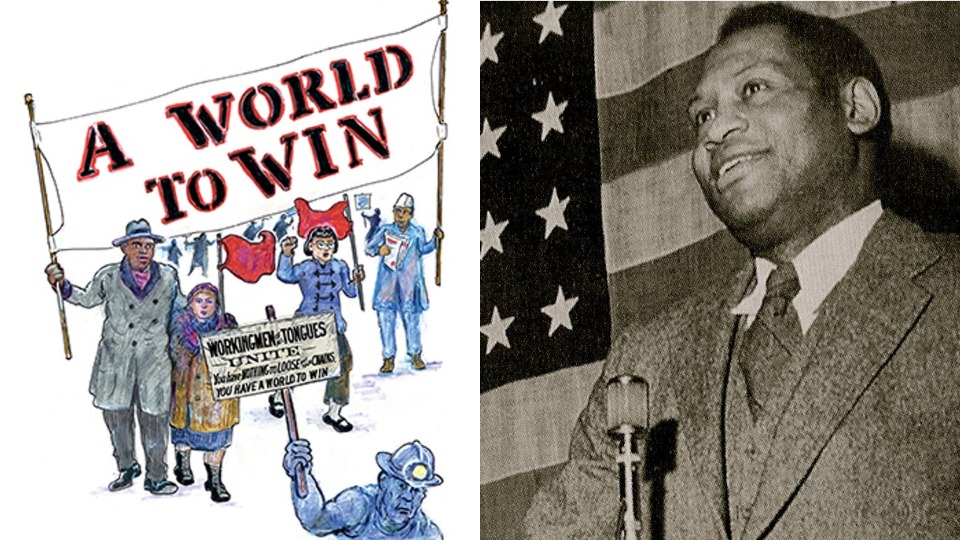
This has been a tumultuous year. Millions marched in the streets against police brutality and violence after the killing of George Floyd. They were tear-gassed, shot with rubber bullets and percussion grenades, and run over, among any number of other civil liberties abuses. Their demand was “Black Lives Matter!”
Their persistence has scored some gains. Not only have racist statues been torn down, not only did Mississippi vote to remove the Confederate symbol from its flag, not only are AFL-CIO central labor councils discussing the expulsion of racist police associations, in addition to all of this—and so much more—the first Black Lives Matter activist, Cori Bush, is now serving in Congress (Democrat-1st District) in St. Louis, just a stone’s throw from where Michael Brown was killed by police in 2014. Even with all these wins, a lot more remains to be done of course.

But with all of this in mind, it’s appropriate that a new biography of Paul Robeson—one of the most dynamic, well-known, and loved civil rights leaders of the 20th century—should come to press.
A Graphic Biography of Paul Robeson: Ballad of an American by Sharon Rudahl, Paul Buhle, and Lawrence Ware is a unique mix of art, history, and radical narrative. It is a welcome introduction to Robeson’s unsurpassed contributions to the struggles for workers’ rights, African American equality, peace, and—yes—socialism.
Robeson, like many African Americans of his generation, was born of former slaves. His father, who escaped through the Underground Railroad and later became a minister, instilled in young Paul a sense of duty to his people and his class.
Robeson as a young boy experienced racism in academics, sports, and music—all things he excelled at. Despite being a top student, Paul’s racist principal did not let him know about a special Rutgers University entrance exam awarding a full scholarship to the winner. In spite of this, Robeson “was the top scoring candidate in New Jersey.” So began his academic career at Rutgers, where he soon immersed himself as an athlete, singer, and academic.
Rudahl, Buhle, and Ware do a wonderful job of condensing Robeson’s early years. The graphic art and narration, coupled with the biographical information, are an easy read—just like a comic book. This makes Ballad of an American a useful text not only for older readers, but for younger students as well. It could easily be incorporated as part of a junior high African-American history curriculum.
Of most interest to this reviewer is Robeson’s activist-political career, and I’m happy to say that Rudahl, Buhle, and Ware do a wonderful job of capturing—as much as a short, graphic biography can capture—the complexities of global political commitments within the context of the Great Depression, World War II, and Cold War.
By the 1930s, Robeson was already world-renowned and quite wealthy, though he never forgot where he came from—his people, nor his class. Success did not temper his politics.
It was during a trip to the Soviet Union in 1934 that Robeson began to articulate an affinity for Soviet socialism and its contributions to the struggle for African-American equality and Black liberation globally. He said, “Here I am not a Negro, but a human being…I walk in full human dignity.”
It was Robeson’s affinity for Soviet socialism and his friendships with prominent Black Communists such as Benjamin Davis, Jr., William L. Patterson, Alphaeus Hunton, and Ferdinand Smith—as well as with the Communist Party USA as an organization—that eventually lead to his blacklisting in the United States, his passport being revoked, and his near isolation later in life.
It is on the tricky question of Robeson’s relationship to the CPUSA that I have one minor quip with Rudahl, Buhle, and Ware’s otherwise wonderful contribution.
Perhaps, as a by-product of Rutgers University attempting to whitewash or sanitize Robeson’s Communist affiliations, Rudahl, Buhle, and Ware chose to minimize this aspect of Robeson’s life? Perhaps there just wasn’t enough space in a compact book to go into the amount of detail this reviewer believes is warranted?
That Robeson’s relationship to the CPUSA is only mentioned in passing or in relation to House Un-American Activities Committee hearings is problematic, especially as Soviet socialism and the CPUSA so clearly played profound parts in his political life.
With that in mind, I’ll end my review with a quote from Robeson. In 1956, as he was being questioned by HUAC political inquisitors, Robeson was asked why he didn’t just “stay in Russia?” His reply is just as relevant today as President Trump, Republicans and Democrats, and various organizations—like the so-called Victims of Communism Memorial Foundation—work to initiate another Red Scare.
Robeson replied: “Because my father was a slave, and my people died to build this country, and I am going to stay here and have a part in it just like you. And no fascist-minded people will drive me from it. Is that clear?”
Aside from the minor quip mentioned above, A Graphic Biography of Paul Robeson: Ballad of an American is highly recommended and would make a great stocking-stuffer this holiday season.
A Graphic Biography of Paul Robeson: Ballad of an American
By Sharon Rudahl, Paul Buhle, and Lawrence Ware
Rutgers University Press, 2020, 142 pp.










